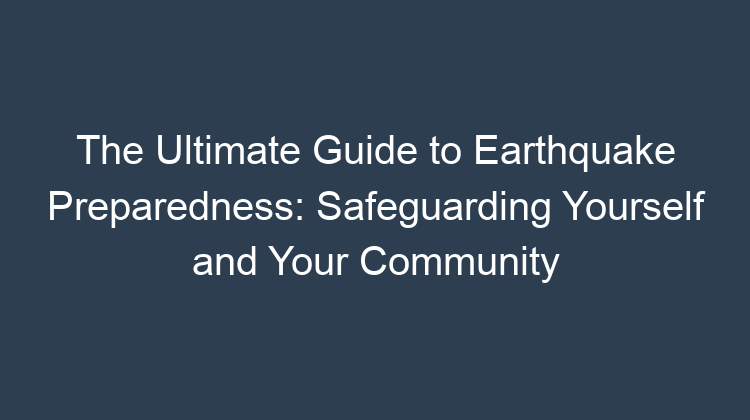Earthquakes can strike with devastating force, leaving behind a trail of destruction and loss. While we cannot predict when or where an earthquake will occur, we can take steps to prepare ourselves and our communities to minimize the impact of these natural disasters. Let’s delve into the best ways to prepare for an earthquake and ensure our resilience in the face of this formidable challenge.
Preparing for an earthquake requires a comprehensive approach that encompasses various aspects of our lives and environments. By implementing these precautionary measures, we can enhance our safety and the well-being of our communities during and after an earthquake. Stay informed, stay prepared, and stay safe.
The best way to prepare for an earthquake is to create a plan and practice it regularly. This plan should include what to do before, during, and after an earthquake. It is also important to have an earthquake preparedness kit that contains essential supplies such as food, water, first aid supplies, and a battery-powered radio.
1. Earthquake Preparedness: A Foundation for Safety
1.1. Understand Your Earthquake Risk:
The first step towards earthquake preparedness is understanding the seismic risks associated with your region. Learn about the types of earthquakes that can occur, their frequency, and the potential magnitude. This knowledge will help you make informed decisions about how to prepare your home and community.
1.2. Secure Your Home:
To minimize structural damage during an earthquake, conduct a thorough inspection of your home for potential hazards. Identify and secure loose objects, and ensure that heavy furniture and appliances are properly anchored. Pay attention to chimneys, water heaters, and gas lines, as these can pose additional risks.
1.3. Stockpile Essential Supplies:
Assembling an earthquake preparedness kit is crucial for sustaining yourself and your family in the aftermath of a disaster. This kit should include non-perishable food, water, first aid supplies, a battery-powered radio, and a flashlight. Regularly check and replenish the kit to ensure its contents remain fresh and functional.
2. Preparing Your Community: A Collaborative Effort
2.1. Educate and Inform:
Raising awareness about earthquake preparedness within your community is essential. Organize educational seminars, workshops, and drills to inform residents about earthquake risks, safety measures, and emergency response plans. Collaborate with local authorities and organizations to ensure that everyone has access to accurate and up-to-date information.
2.2. Strengthen Community Infrastructure:
Advocate for the implementation of earthquake-resistant building codes and retrofitting programs to enhance the resilience of public buildings, schools, and hospitals. Encourage the adoption of seismic design standards for new construction projects to minimize damage and injuries during earthquakes.
2.3. Develop Emergency Response Plans:
Coordinate with local authorities to develop and implement comprehensive emergency response plans that outline procedures for evacuation, search and rescue operations, and the distribution of aid. Ensure that these plans are regularly updated and tested to guarantee their effectiveness during an actual earthquake.
3. Workplace Earthquake Preparedness: Ensuring Safety at Work
3.1. Conduct Workplace Risk Assessments:
Assess the earthquake risks associated with your workplace and identify potential hazards such as unstable structures, heavy machinery, and hazardous materials. Implement measures to mitigate these risks, including securing equipment, conducting drills, and training employees in emergency procedures.
3.2. Develop Emergency Plans:
Create a comprehensive emergency plan that outlines the roles and responsibilities of employees during an earthquake. This plan should include procedures for evacuating the workplace, providing first aid, and communicating with emergency responders. Regularly review and update the plan to ensure its effectiveness.
3.3. Train Employees in Earthquake Preparedness:
Provide employees with training on earthquake preparedness, including how to stay safe during an earthquake, how to evacuate the workplace, and how to provide first aid. Conduct regular drills to ensure that employees are familiar with the plan and can respond quickly and effectively in the event of an earthquake.
4. Personal Preparedness: Ensuring Individual Safety
4.1. Know Your Evacuation Plan:
Develop an evacuation plan for your home and workplace that includes safe routes and designated meeting places. Familiarize yourself with the layout of your surroundings and identify potential hazards that may impede your evacuation.
4.2. Practice Drop, Cover, and Hold On:
Memorize and practice the “Drop, Cover, and Hold On” technique. During an earthquake, immediately drop to the ground, take cover under a sturdy table or desk, and hold on until the shaking stops. Stay away from windows, outside doors and walls, and anything that could fall, such as lighting fixtures or furniture.
4.3. Be Prepared to Help Others:
Learn basic first aid skills so that you can help yourself and others in the event of an earthquake. Keep a first aid kit in your home, car, and workplace, and know how to use it.
5. After an Earthquake: Response and Recovery
5.1. Stay Calm and Check for Injuries:
After an earthquake, remain calm and check yourself and others for injuries. If you are injured, seek medical attention immediately. If you are trapped, do not move around unnecessarily and try to signal for help.
5.2. Check for Damage and Hazards:
Inspect your home for damage and hazards, such as downed power lines, gas leaks, or structural damage. If you find any damage, do not enter the building until it has been inspected and deemed safe by a qualified professional.
5.3. Cooperate with Emergency Responders:
Follow the instructions of emergency responders and cooperate with their efforts. Be patient and understanding as they work to help everyone who has been affected by the earthquake.
6. Frequently Asked Questions
6.1. How often should I practice my earthquake plan?
You should practice your earthquake plan at least once a year, and more often if you live in a high-risk area.
6.2. What should I include in my earthquake preparedness kit?
Your earthquake preparedness kit should include food, water, first aid supplies, a battery-powered radio, and a flashlight.
6.3. What should I do if I am caught outside during an earthquake?
If you are caught outside during an earthquake, find a clear spot away from buildings, trees, and power lines. Drop to the ground, cover your head and neck, and hold on until the shaking stops.
6.4. How can I help my community prepare for an earthquake?
You can help your community prepare for an earthquake by educating yourself about earthquake risks, volunteering with local emergency response organizations, and advocating for earthquake-resistant building codes.
6.5. What should I do after an earthquake?
After an earthquake, check yourself and others for injuries, inspect your home for damage, and cooperate with emergency responders.
7. Conclusion
Preparing for an earthquake is an essential step towards safeguarding yourself, your family, and your community from the devastating effects of this natural disaster. By implementing the precautionary measures outlined in this comprehensive guide, you can minimize risks, enhance resilience, and navigate the aftermath of an earthquake with greater confidence and preparedness. Remember, knowledge is power, and preparedness is the key to survival. Embark on this journey of earthquake preparedness and ensure your readiness to face this formidable challenge with courage and determination.







